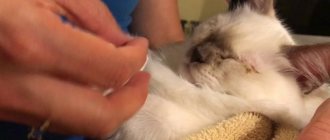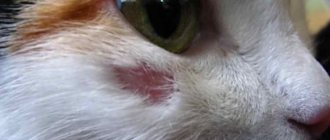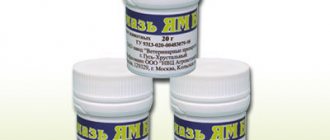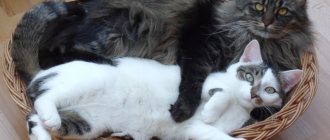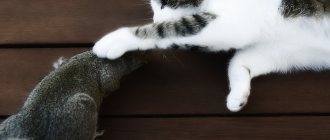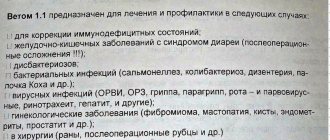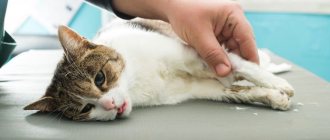How to treat ringworm in cats at home
Ringworm in cats: what it looks like, treatment, signs
For complete therapy, it is important not only to know how to treat lichen in a cat, but also to be able to properly treat the skin areas affected by the fungus. Step-by-step instruction:
- trim the fur carefully. In some cases, the veterinarian may recommend trimming the animal completely;
- You need to cut your hair with sterile instruments and avoid scratches and wounds while cutting - the infection will spread even faster through the blood. After use, the scissors must be sterilized again, and the wool must be washed down the drain or thrown into a bucket in a tightly tied bag;
- It is easier to apply antifungal ointments and creams to the trimmed area, the drugs are absorbed into the skin faster;
- The products are applied only with gloves, otherwise you will have to treat yourself. Ringworm from an animal is easily transmitted to humans if there are scratches and hangnails on the hands.
During treatment, the animal must be isolated from people and pets. The cat should not be allowed on the bed or chairs; it needs to be given a separate place. The pet should not feel abandoned or punished. Despite the fact that cats are considered independent animals, they are very sensitive to loneliness. During isolation, the cat should have his toys, a litter box, and enough food and water nearby.
How to apply ointment correctly
All antifungal external preparations must be applied to previously cleansed and dried skin. In this case, owners must observe personal hygiene rules and use protective gloves.
You need to know that the largest number of pathogens are concentrated at the border of healthy and affected skin. Therefore, in the process of applying ointment to the skin when treating lichen, it is necessary to touch areas adjacent to the affected area (0.5-1 cm wide).
Effective treatment of the disease with medication
Ringworm in cats: treatment, vaccine, folk remedies
If a cat develops lichen, how to treat it is decided by the veterinarian after conducting the necessary examinations. The choice of a specific drug depends on the degree of skin damage in the animal, the size of the lichen formations, the age and breed of the animal. The general state of health and existing diseases are also taken into account. To treat lichen in cats, drugs are prescribed in three types:
- for internal reception;
- injections;
- for external use.
Often these drugs are combined with each other to make the therapy more effective. It will take 1 to 2 weeks for the external manifestations of lichen to heal. If there is no purulent inflammation, new healthy hair will grow in a month. With a complicated form of the disease, the cat may be left with scars.
To prevent complications, you should consult a doctor at the first symptoms of lichen.
Important! After the disappearance of external symptoms, it is necessary to get tested - the infection can remain hidden in the body. In this case, it will be more difficult to remove lichen.
Ringworm in cats: drugs for treatment
In animals, lichen often becomes protracted, so injections and tablets are more effective in treating the disease. For oral administration, cats are often prescribed:
- Itraconazole;
- Terbinafine;
- Giseofulvin.
Medicines are given in crushed form, mixed into food. The dosage of drugs and the duration of the course are prescribed only by a doctor. You should not self-medicate, so as not to harm the animal even more.
In addition to tablets, the cat is prescribed intramuscular injections of Dermicocide. The drug is injected into the thigh 2-3 times, after which a break of 5 days is taken. The product has contraindications due to age; it cannot be injected into cats during pregnancy.
Ointments and shampoos
Ointments are effective in the treatment of weeping lichen in cats:
- salicylic ointment. Strong antiseptic, relieves inflammation and itching. The product should be applied to the areas affected by the fungus; the procedure is carried out twice a day. The treatment course lasts on average 14 days;
- ichthyol ointment. It is effective in treating fungal diseases, but it is worth considering that the animal may not like its pungent odor. Accelerates tissue restoration, destroys pathogens, relieves inflammation. The product is applied to the cat’s skin three times a day;
- tar ointment. Accelerates the healing of wounds from lichen. Therapy lasts from 1 to 1.5 weeks.
To prevent the cat from trying to lick the ointment with its tongue, you need to apply gauze folded several times to the treated area and secure it with a band-aid. In addition to ointments, shampoos against lichen are effective:
- Sebozol;
- Doctor;
- Nizoral.
Shampoos are applied to the affected areas, foamed and washed off with warm water 3 to 5 minutes after application. If the cat is still small, then it is better to check with the doctor whether the listed drugs can be used.
Shampoo must be used strictly according to the instructions.
INDICATIONS FOR USE. MAIN CONTRAINDICATIONS
Before using YAM ointment for dogs, you should carefully read the instructions included with each package. The product does not have an irritating or sensitizing effect. Suitable for treating animals of any age and breed, there are no contraindications.
YAM ointment is suitable for treating animals of any age and breed; there are no contraindications.
An individual allergic reaction to the components of the drug is possible. Signs of allergy appear immediately after use, including itching, nausea, and local swelling. Antihistamines will help relieve symptoms.
Skin lesions in animals can be fungal or viral in nature. The most common ringworm in cats is caused by the pathogenic fungi Trichophyton and Microsporum. Other, less common varieties of lichen include:
- pink (viral in nature);
- red flat (etiology unclear);
- multi-colored (pityriasis) (fungal nature);
- weeping (eczema).
Ointments of various types can be used to treat any of these types of diseases, except pityriasis rosea. No specific treatment has been developed for it. Your cat needs good nutrition and a healthy immune system. A symptom of this type of disease is a multitude of pink spots located throughout the body, which over time become yellowish. Wrinkles on the skin begin to appear in the affected areas.
The ointment is an effective remedy for the most common type of lichen - ringworm. A fungal infection most often affects the face, the area behind the ears, paws and tail. In some areas, the skin begins to become covered with scales and peel off, and baldness in the affected area is observed (as if six were cut off).
If a pet owner notices such abnormalities on the skin, it is necessary to immediately begin treatment, since the disease causes severe discomfort to the animal. The fungus can quickly spread on surfaces and be transmitted to humans, so it is advisable to isolate the cat from children (who have not yet developed immunity to fight the fungal infection).
We suggest you read: Read the book Quail on your mini-farm. Modern growing technologies by Alexander Snegov: online reading
If the disease cannot be cured with local medications, then the help of a specialist will be required. The veterinarian may decide to prescribe oral medications. Most often they are used in severe or severely advanced cases.
Important! Treatment of lichen with any tablets is prohibited for pregnant and lactating cats and kittens.
For animals
Indications for the use of this medicinal product in domestic and farm animals are skin diseases caused by the activation of psoroptoid and sarcoptoid mites (dermatitis, eczema), as well as microsporia, scabies, trichophytosis, etc. Yam Bk ointment is also prescribed for lichen for dogs and other domestic animals (except cats).
For people
Some dermatologists recommend that their patients use this drug for demodicosis and rosacea, which have developed as a result of the activation of Demodex mites.
For animals
The use of the drug is prohibited if the animal is observed to be hypersensitive to the ingredients of the drug.
Due to the species' high sensitivity to tar, I do not recommend using Yam Bk ointment for cats (for lichen, eczema, scabies, dermatitis, etc.).
For people
The drug should not be prescribed to pregnant and lactating women, as well as people with personal hypersensitivity to any ingredient of the medicinal product, hypertrichosis, mechanically damaged skin (scratches, cracks, hematomas, etc.).
How to treat ringworm in a cat
Sulfuric ointment
Antihistamines for cats: what to give for allergies
Sulfur ointment against ringworm for cats is used to combat any form of the disease. The drug is based on sulfur, it has pronounced medicinal properties:
- relieves inflammation;
- exfoliates dead skin particles, in place of which new healthy tissue is formed;
- destroys fungi and bacteria;
- eliminates itching.
Used for external treatment of lichen in cats as an adjuvant. The ointment destroys the external manifestations of the disease, but for a complete recovery the animal will need a course of injections or tablets.
Fungin
Available in spray form, it is used to treat skin fungal diseases in cats. Components:
- clotrimazole;
- propolis.
The drug is used only as prescribed by a doctor. Clotrimazole fights fungal infections, and propolis softens the skin, relieving itching and inflammation. Once a day, the product is applied to the affected area and the skin around it. Duration of therapy is 15 days. The dose of the drug is 0.3 ml per 1 kg of pet’s weight.
Sanoderm
A fungicidal drug with anti-inflammatory and antibacterial properties based on clotrimazole. Apply a thin layer of ointment to the lichen and gently rub it into the skin twice a day. The course is from 2 weeks to a month, after which you need to take a break. Sanoderm should not be overused, as this can lead to disruption of the adrenal glands.
Ketoconazole for cats
Intended for the treatment of lichen in humans; for animals, the daily dose is calculated at the rate of 4-8 mg per 1 kg of weight. The tablets are crushed and given once a day for 7 days. If necessary, the course of treatment is extended, strictly monitoring the dosage.
If abused, Ketoconazole negatively affects the functioning of the liver and gastrointestinal tract. For use on adult animals only. Side effects include an allergic reaction, photophobia, nausea, and dizziness.
Fluconazole for a cat
The drug is in capsule form, the main active ingredient is fluconazole. Destroys fungus and prevents new microorganisms from developing. The drug is quickly absorbed into the blood; it can be given to the cat during meals, before or after.
The capsules are very easy to dose.
It is convenient to divide the contents of the capsules into doses; 8-12 mg of the drug is needed per 1 kg of animal weight. The drug is given once a day, the duration of the course depends on the therapeutic effect. If symptoms of the disease remain after 3 weeks of use, you should contact your veterinarian.
Clotrimazole
The ointment is applied to the affected areas 2-3 times a day. After a week, positive changes will be noticeable, but complete recovery will require a course of 1 month. Ointments can be combined with tablets; be sure to consult a doctor before treatment.
Miconazole for cats
To successfully treat cats with lichen, Miconazole is prescribed as an ointment. It is applied to lichen 2 to 3 times a day, the frequency depends on the severity of the disease. The course lasts until external signs of infection disappear and continues for a couple more days for prevention. Miconazole should not be combined with other external agents. Not suitable for treating cats under 1 year of age.
The first signs of lichen
Most mycotic skin lesions are the result of the activity of Microsporum and Trichophyton fungi. The first pathological areas are microscopic hairless surfaces that you can notice on the nose, behind the ears, on the paws. The skin becomes gray or pink and peels off. The scales fall off. They are carried by the wind and become a source of infection for other animals and humans. A whitish mycelium of the fungus appears on the roots of the hair.
Micromycetes grow and irritate nerve endings. Cause itching. You may not see the pathological area. But if you notice that your pet is constantly scratching the same place, examine it. If there are no fleas, then the cause is a fungus. However, most often both factors are present.
Areas of alopecia quickly expand, the exposed skin thickens, becomes rough, and becomes covered with ugly bumps. The fur becomes thinner and breaks in the middle. The surface of the skin looks as if it has been cut. Hence the common name “ringworm”.
The pet scratches the itchy area with its claws, ichor is released, and crusts form. The dog tears off the scabs, the open wounds become contaminated with microflora, and suppuration develops.
The disease may begin with the appearance of pink spots. This is the result of viral multiplication, which occurs when immunity decreases. The reason for the weakening of protection is stress, poor nutrition, and unsanitary conditions. The disease can go away on its own, but if secondary microflora joins, a serious illness develops.
Another variety is malassezia. The fungus constantly lives on the dog, but becomes aggressive when the immune system is weakened. The onset of the disease can be heat and clumping of hair in long-haired animals. At first, you will not notice any visible changes on the skin; your pet will simply itch for a long time in the same places. Then inflammation occurs on the face in the form of pimples or in the ear.
Based on clinical signs, it is difficult to determine which particular type of micromycete plays the main role in pathogenesis. Laboratory tests are required to identify the pathogen.
Ringworm vaccine
Vaccination is the fastest method of treating lichen in cats. It is also effective for preventive purposes, the only difference is in the dosage of the drug. There are three vaccine options:
- Polivac TM;
- Vakderm;
- Microderm.
The course of treatment consists of a series of 2 - 3 intramuscular injections with a break of 14 days. After the first stage, the animal’s condition becomes significantly better. Vaccination can be combined with drugs for external use to make treatment even faster and more effective.
Important! Injections should not be given to kittens and adult cats during pregnancy. Injections are contraindicated for infectious and inflammatory diseases.
Features of application
Treating cats and dogs, as well as dogs, with the use of Clotrimazole is a fairly common practice. There are some side effects to consider. For example: burning, swelling, itching.
© shutterstock
When your cat gets ringworm, it should be treated as follows: the foci of infection are lubricated with Clotrimazole until complete healing. Usually this procedure is repeated 2-3 times a day. The product is applied in a thin layer. Rub in carefully. The cat must be restrained so that it does not lick it off. Duration - a week. This is followed by a repeat course for 3-4 weeks. In it, Clotrimazole is already applied 1-2 times a day.
Owners often have a question: how to use Clotrimazole to a cat if the affected area is too large?
Whatever the scale of the lesion, the first step is to wash the affected area with soap with a neutral pH value and dry it. Clotrimazole is applied in a thin layer, covering the entire area of inflammation. The procedure is performed more often and longer. That is, 3-4 times a day. Duration – 3-4 weeks. In any case, you should prevent your cat from scratching or licking the affected area. The use of additional drugs is possible. The same Clotrimazole tablets and other medications may be prescribed.
How to remove ringworm from a cat using folk remedies
It is not always possible to use a vaccine or purchase drugs to treat lichen at a veterinary pharmacy. In this case, it makes sense to use homemade recipes. Folk remedies are good at the initial stage of the disease, but they are best used as additional therapy in parallel with medication. It is advisable to check with your veterinarian in advance about how medications are combined with home remedies.
Traditional medicine recipes should be used carefully and only after consulting a doctor.
Before you begin treating the affected skin, you need to carefully trim the hair. The procedure is carried out strictly with gloves to avoid infection with fungus. Then you can use any of the following options:
- iodine. Universal disinfectant. It is enough to lubricate the skin around the affected area twice a day;
- celandine. This medicinal plant has long been used to treat skin diseases. For treatment you will need juice from fresh celandine stems. The plant must be collected in an ecological zone without chemical production nearby. The stems are finely chopped, wrapped in gauze and the juice is squeezed out. The prepared product should be applied to the lichen 3 times a day. Avoid contact with eyes and mouth;
- lemon juice. Acid destroys pathogens and speeds up the healing process. In order not to harm the cat, lemon juice is mixed with olive oil and lubricated on the affected areas 4 times a day;
- herbal collection To prepare a medicinal decoction you will need chamomile, nettle, creeping thyme, string and oregano. Collected or purchased herbs are mixed in equal quantities and brewed with boiling water at the rate of 200 ml of water per 2 tbsp. spoons of raw materials. The mixture should boil for half an hour in a water bath, then the broth is cooled, filtered and given to the cat 1 tbsp. spoon before eating;
- essential oil. Tea tree essential oil has pronounced antifungal properties. To treat ringworm, it is applied to the affected areas. Before use, essential oil must be diluted with regular olive oil - 3 drops per 1 tbsp. spoon;
- alcohol solution. A topical treatment for lichen can be prepared by mixing 30 ml of alcohol with an aspirin tablet.
Before using any herbs, you must make sure that the animal is not allergic to them.
Traditional methods
If pigmentation on the cat’s body has just begun to appear and has not yet spread, you can use traditional methods of treating the disease.
Solidol for lichen in cats
Solidol is considered one of the most effective home remedies for treating pathology. However, the product has an unpleasant odor and may cause allergies. Therefore, it must be used with caution.
Solidol is applied to previously washed affected areas using a spot method and left for several hours. It is best to carry out the procedure at night, and in the morning remove any remaining product with a damp cloth.
Is it possible to cure ringworm with iodine?
Iodine can be used in the development of skin pathology at its early stage. Step-by-step instruction:
- Wash the affected area and remove hair from it (only the affected area needs to be cut).
- Apply iodine with a mesh.
- Update it every day morning and evening.
The course of treatment with iodine should not exceed more than a week. If the drug does not give a productive result, you should consult a doctor.
Iodine can be replaced with vinegar.
Treatment of lichen with iodine is an old-fashioned method that works only at the initial stage of the disease
Zinc ointment for lichen in cats
Zinc ointment also helps block the inflammatory focus in the early stages of the pathology. The product is used twice a day, it is applied to the cleansed skin of the animal in a thin layer and removed after 3-4 hours. The course of treatment should not exceed 10 days. How to tell if your cat is getting rid of shingles:
- the spots began to decrease in size;
- the pet has stopped itching;
- The crusts on the body disappeared.
Important! As the animal recovers, stable sleep and appetite return. You can find out how long it will take from your attending physician who is familiar with the picture of the disease.
Treatment of the premises for ringworm
It is not enough to cure lichen in a cat; you need to carefully treat the room from fungus. Ringworm spreads quickly, it is dangerous to other animals and people, and the risk of re-infection increases. Home treatment is also a preventive measure, so it is very important:
- Wash your pet's bed regularly;
- clean carpets and upholstery with disinfectants;
- wash clothes and bedding regularly;
- Carry out wet cleaning in the house on time.
Owners can become infected with lichen from their pets. This most often happens to those who have weakened immune systems due to illness, children and the elderly. Regular cleaning and ventilation is enough to prevent infection.
Prevention and timely consultation with a doctor is the key to a cat’s health.
As a result, it is not necessary to let your cat go for a walk for him to become infected with shingles. Fungal spores are carried on shoes and clothing and, if the animal is weakened, it can become ill. To prevent this, you need to regularly clean, treat clothes and linen, monitor your pet’s immunity and get vaccinations on time. If infection occurs, complete recovery will take up to 1-2 months. It is most effective to combine ointments and tablets; the doctor will prescribe specific medications and dosage.
Application and dosage
Treatment for onychomycosis can last from six to twelve months. In cases of severe infection, surgical declawing may be the only effective method of getting rid of the fungus.
Instructions for use of Terbinafine for cats contain information that treatment lasts approximately four to six weeks and is stopped only after a negative test result for a fungal infection is obtained. This is important because even if there are no symptoms of the disease, it can be positive.
The cat is considered recovered only after receiving a second negative culture result for the fungus four weeks after the end of the course of treatment with the drug. This is explained by the fact that in the 1st study, the negative result was due to the persistence of Terbinafine in the skin fragments and hairs that were taken for analysis.
In practice, repeat analysis is rarely done, as cat owners refuse to have it performed.
Terbinafine tablets for cats should be used in a dose of 20 to 30 mg per 1 kg of animal body weight once a day, a little later - every other day. The duration of treatment averages 32-34 days. It is recommended to give the drug to the cat during feeding.
Small kittens that may be harmed by the tablets should be treated externally, lubricating the affected areas with ointment or cream. The duration of treatment depends on the pet’s immunity - the stronger it is, the shorter the course will be.
Terbinafine is the best option for a drug used to treat microsporia in pets. In any case, treatment should be selected by a veterinarian based on the individual characteristics of the cat, the degree of advanced disease, the age of the animal and test results.
Homemade ointments
There are recipes for ointments that you can prepare with your own hands to treat lichen.
- Take raw grated beets and natural honey in equal parts (for example, 50 grams), mix, apply to the affected areas, leave for several hours;
- mix a teaspoon of citric acid with three tablespoons of olive oil. Gently rub the resulting mixture into the affected areas and leave for an hour.
Vishnevsky ointment, a drug that contains tar, can be used for people to treat lichen. This component is a natural antiseptic that inhibits pathogenic microorganisms, accelerates the healing process, disinfects the skin and renews it.
Those who treat lichen at home often wonder: is it possible to smear lichen with brilliant green? This is not recommended if there are ulcers on the skin. Only unopened bubbles can be lubricated with the product. Thanks to brilliant green, you can disinfect the skin and also note the appearance of new rashes.
How to treat lichen in humans? This disease requires an integrated approach: the use of ointments is only part of the therapeutic process. A specialist will help you choose an effective remedy. There are quite a lot of their names, and not every one is suitable for a specific type of lichen.
